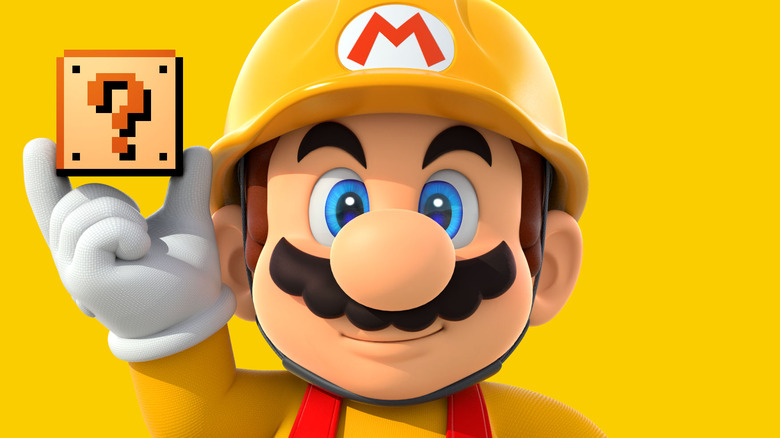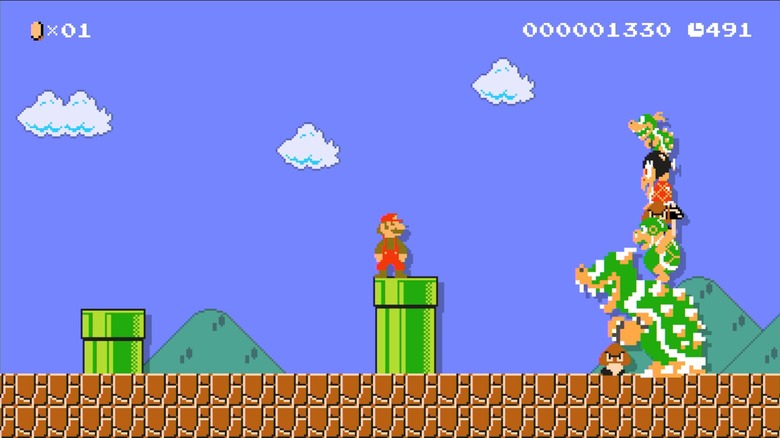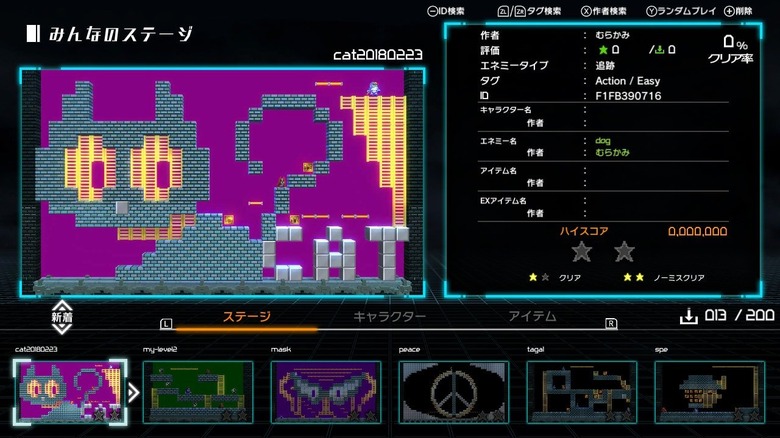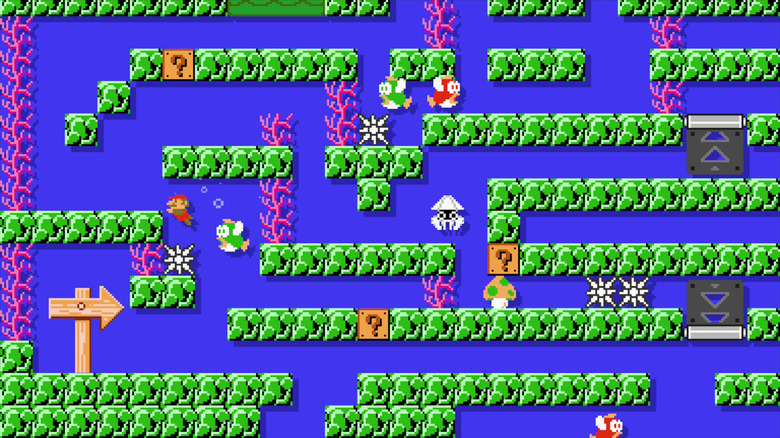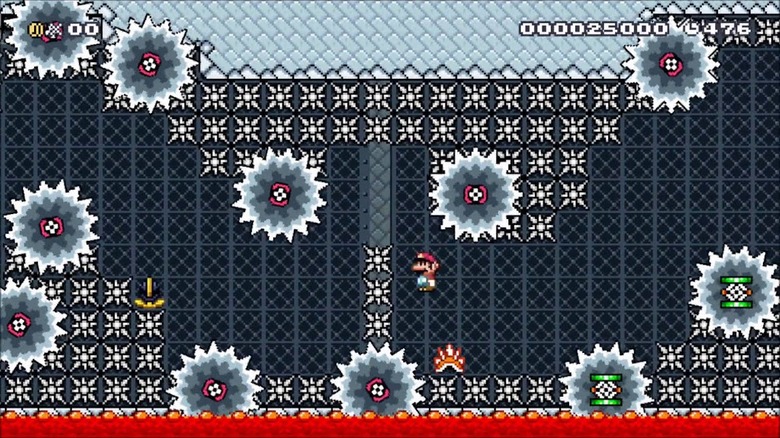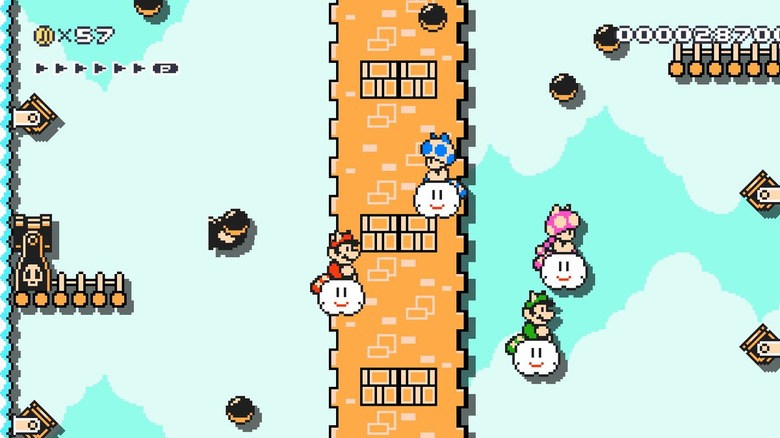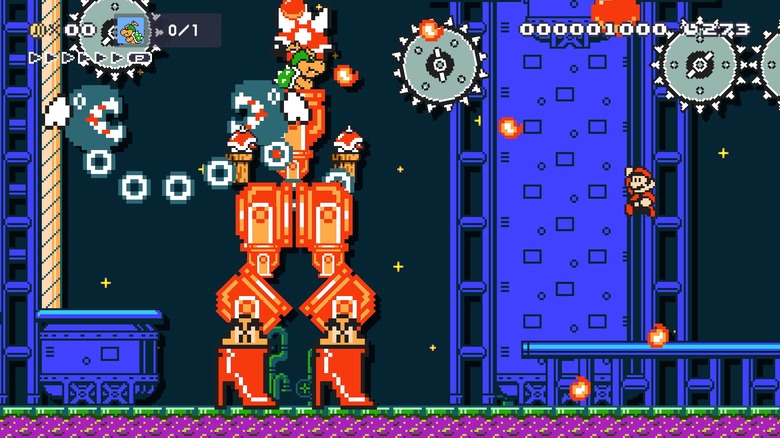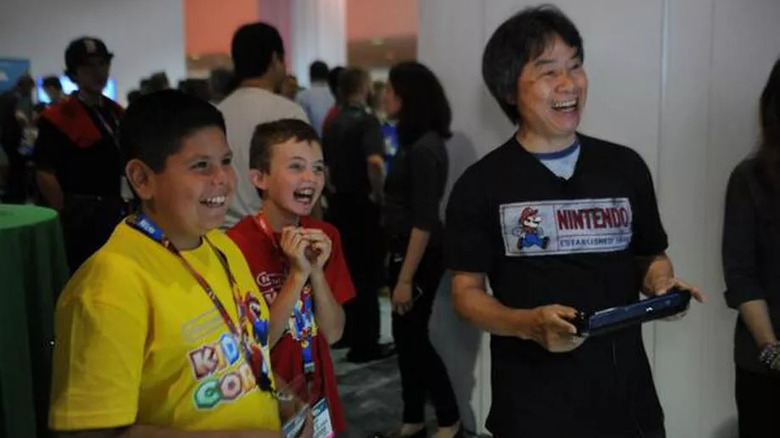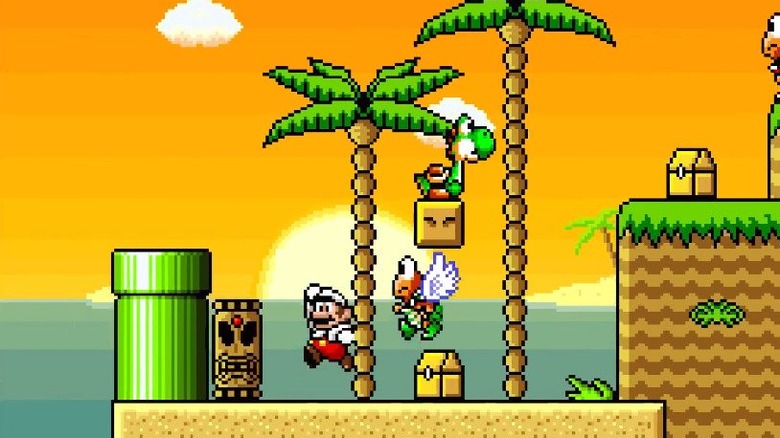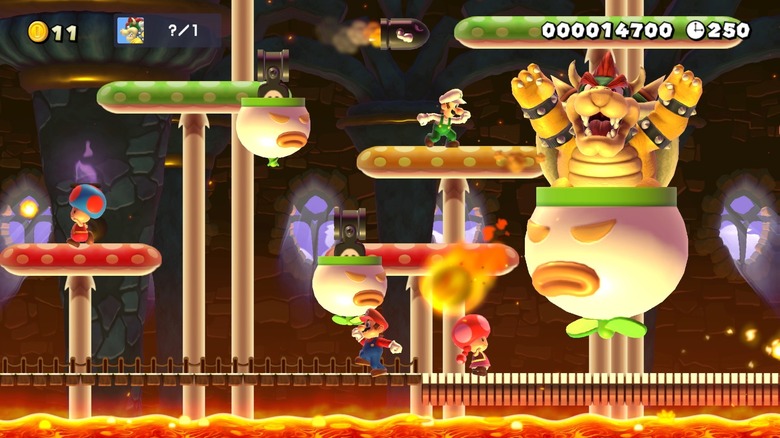How Super Mario Maker Changed Video Games And No One Noticed
Super Mario Maker didn't start a revolution. Level editors have been around since the early '80s. As much as fans want them, we still haven't gotten Zelda Maker, Metroid Maker, or Sonic Maker. Titles like Dreams, Roblox, and Rec Room let you make your own games, but they don't seem to take many — if any — cues from Super Mario Maker.
But that doesn't mean that Super Mario Maker hasn't had a profound impact on the video game scene. By creating a level editor that feels more like a game than a tool, Nintendo brought game design to the masses. Making Super Mario Bros. levels isn't just fun: it's educational. Spend a significant amount of time with Super Mario Maker, and you'll never look at Mario — or other games — the same way again.
SMM taught fans all over the world how to make games and redefined the most famous video game character ever, upending decades of tradition. All that, and it's still a unique experience. That's what makes Super Mario Maker so special: even now, there's nothing else quite like it.
A new perspective on an old favorite
Super Mario Bros. didn't become an instant classic by accident. More than three decades after its debut, the NES' signature platformer remains one of the best-designed games of all time. Super Mario Maker showed people why.
Anyone who has any interest in game design has probably studied Super Mario Bros.' iconic 1-1 stage, and analyzed how the level teaches players how Mario works. With Super Mario Maker, they could put what they learned into practice, and then see how well they learned. Mario Maker tells you where people are having trouble in your stage. Other players can leave comments, too, telling you what they liked about your level — and, more importantly, what they didn't. Editing your level to address those problems isn't just a good idea. It's a perfect introduction to the iterative design process that forms the backbone of modern game development.
SMM made it clear just how well made the games in Nintendo's flagship franchise are (most of them, anyway), and helped educate a wide audience on what makes Mario work. People came away with a newfound appreciation for both Mario and game design, and the overall community is better for it.
Reinventing the level editor
Super Mario Maker isn't the first game to focus on level creation. Players have been able to create their own platforming stages since at least the early '80s, when Lode Runner arrived on home PCs. Level-editing tools are a large part of Doom's ongoing popularity, while PlayStation titles like LittleBigPlanet and ModNation Racers caught the user-generated-content train years before Nintendo hopped on board.
But none of those games have that signature Nintendo flair. Super Mario Maker isn't fun just because you can make Mario levels. It's fun because the level editor is both intuitive and flexible, and because it's full of small touches that make level editing feel like a game itself. Shake objects to change their function. Discover hidden interactions (like, say, dropping a Super Mushroom on an enemy to make it bigger) to unlock new features. Like a good Mario level, SMM's level editor is full of surprises.
It's a new take on level editors, and other games are starting to catch on. The most recent Lode Runner title takes some cues from Mario Maker, as do some fan-made and indie games. Let's hope that others follow suit. Creation is satisfying on its own, but Super Mario Maker takes game design to a whole new, well, level.
It ain't easy
Spend enough time on gaming forums or YouTube, and you'll hear the argument: game developers are lazy. If a game ships with bugs or missing features, or if it simply isn't very fun to play, it's because developers cut corners. As long as they're getting paid, they don't really care.
Wrong. Making games is hard, and Super Mario Maker proved it. Many people have been playing games, especially Mario titles, for their entire lives. They'd spent hours imagining their own Mario levels or doodling stages on pieces of paper, and they rolled into Mario Maker thinking that they were already experts. Then, reality hit. As it turns out, making games — even something as "simple" as a Super Mario Bros. level — takes lots of practice. Even making an "easy" level is harder than it looks.
People either practiced and got better, or gave up and spent their time enjoying other people's creations. Either way is fine. Super Mario Maker made it clear how difficult putting together a good level is, making it more likely that everyone else will cut designers some slack. Like all you frustrated Mario makers, they tried their best.
Mainstreaming masochism
Before Super Mario Maker, Kaizo Mario was the domain of hardcore fans only. The Super Mario World hack, which was created by a psychopath named T. Takemoto, arrived on the internet in 2007 and quickly rose to fame through a series of oddly hilarious YouTube videos that showed one of Takemoto's friends trying (and failing) to master the game.
Super Mario World is fairly gentle. Kaizo Mario is specifically designed to drive players crazy. Blocks appear where you least expect them, foiling your jumps. Enemies are placed exactly where they'll cause the most trouble. In order to beat Kaizo Mario, you'll need to memorize whole stages, master advanced techniques, and execute every move with perfect timing.
Kaizo Mario and its ilk had niche appeal for years. Then, Mario Maker happened. Suddenly, Kaizo-inspired levels were everywhere. Now, even casual Mario fans know about P Switch jumps and Backshots. Streamers like PangeaPangea have built massive audiences by creating nigh-impossible Mario levels, then trying to beat them. As a result, Mario's image has changed. Nintendo's plucky plumber looks cute and cuddly, but he has an edge. It just took Super Mario Maker to find it.
From single-player platformer to spectator sport
The Mario series has dabbled in competitive multiplayer before — it's almost impossible to play New Super Mario Bros. Wii with three other people without wanting to murder everyone involved — but it took Super Mario Maker to turn the world's preeminent platformer into a bona fide esport. In 2015, Nintendo capped off its World Championships tournament with a race through a series of Super Mario Maker levels, and it worked surprisingly well. It was hilarious, proving that Mario could hang with Overwatch, League of Legends, and others.
Nintendo must've agreed, because it's going all in on competitive Super Mario Maker for the sequel. Not only does Super Mario Maker 2 include races through user-made levels as one of its primary multiplayer modes, but Nintendo's E3 2019 festivities included the Super Mario Maker 2 Invitational. During the contest, which takes place alongside esports-friendly games like Splatoon 2 and Super Smash Bros. Ultimate, four top-tier Mario Maker players will duke it out in a three-round competition. Don't be surprised if that's the beginning of a trend. Super Mario Maker competitions are surprisingly fun to watch, and with any luck they're here to stay.
Breaking all of the boundaries
We used to know what to expect from a 2D Mario game. Run from right to left, hop over enemies and obstacles, and reach the goal, nabbing coins and hunting for secrets along the way. That's the formula that Nintendo used for decades. The modern New Super Mario Bros. series is a lot of fun, but it plays things awfully safe. While the official Super Mario Maker trailers upped the chaos, they stuck to that same framework.
When fans got their hands on Super Mario Maker, everything changed. Suddenly, Super Mario Bros. could be a shoot-em-up. It could be a musical instrument. It could be an auto-playing Rube Goldberg machine, a calculator, or even a turn-based RPG, complete with a battle system and dialogue-spouting NPCs.
It looks like Nintendo got the message. The Super Mario Maker 2 trailers feature some of the Mario Maker community's most popular creations, including shumps and Mecha Bowzilla, and we wouldn't be surprised to see that kind of creativity resurface in the next official Mario game. Super Mario Maker taught fans how to make their own Mario levels, but the game's biggest impact might've been showing Nintendo just how versatile their mascot really is.
Introducing Miaymoto Jr.
Face it: Shigeru Miyamoto isn't going to live forever. On the plus side, the next wave of game designers is already at work, and we have Super Mario Maker to thank. SMM isn't just for grizzled Mario vets: kids like it too, and while they play, they're learning how to make games, even if they don't realize it.
Some groups have taken this idea to its natural conclusion, like the San Francisco Public Library, which held special Mario Maker classes to teach kids about software development. Nintendo even sent official representatives to the library to give the little tykes some help. "We're aware of the trend of coding as a thing that's being folded into a lot of curriculum," Nintendo's Kit Ellis said. "We saw some similarities in that, a lot of people are learning coding and being able to make games."
It's too early for these budding game designers to enter the workforce — Super Mario Maker only came out in 2015 — but it's easy to imagine some of them graduating to platforms like Roblox or Twine, and then Unity, Unreal, and other fully-fledged game engines. After all, once you're bitten by the game design bug, it's hard to stop.
To hacks and back
When Nintendo announced Super Mario Maker, one group of fans gave a collective shrug. They'd already been making Super Mario levels for years. For about as long as there have been emulators, there have been ROM hacks, or fan-made versions of existing games. Naturally, Mario is a popular subject for hacking. The Super Mario World ROM hacking community even has its own Mario Maker-like tool, Lunar Magic, which is just as easy to use as Nintendo's official level editor.
At first, there was some concern that Mario Maker would divide the ROM hacking scene. It didn't. In fact, the opposite happened: after Mario Maker came out, the ROM hacking community got bigger. Some players got fed up with Mario Maker's limited functionality, and turned to ROM hacking instead, where they could create new power-ups, items, enemies, and more.
That's important. Some of the most popular Mario Maker trends came from the ROM hacking scene, as did some of its most popular creators, and new blood means new ideas — and new ways to reshape Mario, and 2D platformers, for the future. We can't wait to see what they come up with.
Fans are the future
In 2006, Nintendo released New Super Mario Bros. on the DS, resurrecting the 2D platformers that made Mario a star. It was a big deal. Without the plumber's classic side-scrollers, there'd be no Mario, no Nintendo, and arguably no video game industry at all.
From then on out, Nintendo released a New Super Mario Bros. game every few years. After Super Mario Maker hit, however? Nothing. From a certain perspective, that makes sense. Thanks to Super Mario Maker, there are millions of Mario levels out in the wild. You could play Mario every day for the rest of your life and you still wouldn't finish them all.
As a result, the future of video gaming's most famous character is no longer in Nintendo's hands. It belongs to the players. Nintendo isn't giving up on 2D Mario entirely — Super Mario Maker 2 has a story mode filled with over 100 Nintendo-made levels — but the power has shifted. Fans made Mario who he is. It's only right that they decide who he becomes.

